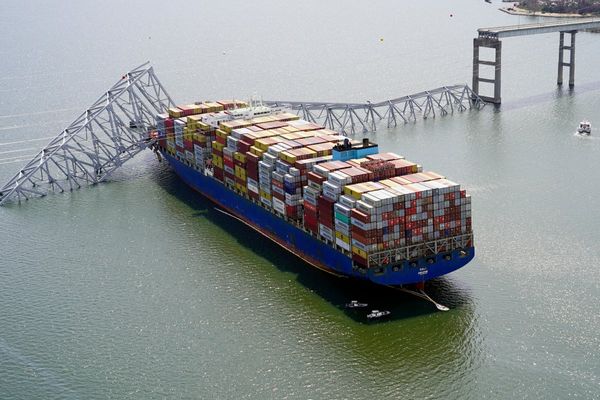Space, we've been told, is the final frontier.
A vast area of emptiness, waiting to be explored and conquered.
This idea may sound captivating, but social scientist and lawyer Douglas Ligor says it's not only problematic, but wrong.
Space, or at least the part that's relatively close to Earth, is actually a very crowded, messy and increasingly dangerous place.
According to Mr Ligor, who is a member of the enterprise space initiative at the RAND Corporation think tank, this largely lawless area is in dire need of better "space laws."
In a recent piece for the NATO Legal Gazette, he warned that if humanity doesn't act, "space is in jeopardy of becoming an unusable graveyard," which could have major consequences for humans back on Earth.
Mountains of space debris
In the early days of space exploration, from the late 1950s to the 1960s, the US and the USSR launched around 750 satellites into space.
This number has grown dramatically. Dozens of countries and companies have since sent about 12,500 satellites into orbit. Today, there are about 4,500 functional satellites and about 3,000 derelict satellites, with the rest burning up or far from Earth.
Humans rely on satellites all the time: For GPS services, some TV signals and telecommunications, and weather forecasting, just to name a few uses.
"Countries and companies intend on sending tens of thousands more satellites into 'low Earth orbit' and 'geostationary orbit' [two main orbits around Earth] within the next couple of decades. So it's about to get very, very crowded," Mr Ligor tells ABC RN's Between the Lines.
Whizzing around these critically important satellites is a huge amount of "space garbage," everything from obsolete rocket parts to a wrench and bolts discarded by an astronaut.
Mr Ligor says there's more than 36,000 pieces of space garbage that are about 10 centimetres in diameter and greater, and around one million pieces that are 1-10 centimetres in diameter.
When it comes to the smaller fragments, there may be upwards of 170 million pieces.
And given space garbage can travel up to speeds of 28,000 kilometres per hour, Mr Ligor says the larger pieces can "destroy, disrupt or disable a satellite or space station."
What does it mean for Earth?
Satellites and space stations can currently manage the debris problem with warning systems and manoeuvring, but this could become increasingly difficult in the future.
Mr Ligor says countries keep creating space debris and can't agree on what to do with it.
The result? "Messy" space is getting messier each day.
Mr Ligor warns of a cascading scenario where debris leads to collisions, which creates more debris and then more collisions (and so on), resulting in a very dangerous environment for space operations.
"The situation is likely to get worse and we could potentially lose parts of low Earth orbit and geostationary orbit if we aren't careful."
What that means is, in a worst-case scenario, humans could lose some satellite capabilities, which may affect all those things like GPS, telecommunications and weather monitoring.
Mr Ligor warned in his recent NATO Legal Gazette piece that losing access to low Earth and geostationary orbits would mean "the global community at all levels could suffer significant social and economic instability, as well as national and international turmoil and insecurity."
"To be sure, this is a worst-case scenario. However, notwithstanding the undetermined probability of such a scenario, experts agree that the potential for catastrophic consequences is very real."
But the one bit of good news is that humans on Earth are very safe from space debris.
According to material from NASA's Orbital Debris Program Office, "a significant amount of debris does not survive the severe heating that occurs during reentry" and pieces that do survive "are most likely to fall into the oceans or other bodies of water or onto sparsely populated regions."
It states "no serious injury or significant property damage caused by re-entering debris has been confirmed."
Space law for collisions
Space law, made up of different international treaties, does already exist.
But Mr Ligor says these treaties "articulate general principles that are broad in scope and ambiguous" and no treaty contains a verification or enforcement mechanism.
In 1972, many nations agreed to the Convention on International Liability for Damage Caused by Space Objects. But Mr Ligor says it's "woefully inadequate" in many situations.
He says the treaty only made countries liable for their objects when they're inside the Earth's atmosphere or if they fall back to Earth. Up in space itself, there are no rules to assign fault.
So if an errant astronaut glove hits a satellite and causes millions of dollars in damage, there's currently no way to determine who's actually at fault.
"[Today] nations and operators can pick and choose which standards they want to apply when … I think the reliance on voluntary norms and voluntary behaviours is what's gotten us into this mess," Mr Ligor says.
As a result, he's advocating for a much stronger system of governance in space.
He suggests adding new protocols to previous treaties or a new treaty "that devises a framework or system of rules that everybody can reliably count on ... [and] that's at least relatively enforceable."
What does the future hold?
Mr Ligor is also worried about how wealthy companies are buying up satellite "real estate" and what this means for countries who are less advanced in space development.
Geostationary orbit is a prime spot for broadcasting and telecommunications satellites so competition to secure a slot is set to become "very, very fierce."
"There's a very limited amount of real estate in the geostationary orbit," he says.
"Companies are essentially trying to get as many of these slots in the orbit as they can … If you have money and resources, you can get the best location and you can box other operators out."
It means countries which are yet to start space programs, especially developing countries, may be totally boxed out of some parts of the space real estate market in the future.
Speculating about what lies even further ahead for space development often sounds like the realm of science fiction. But Mr Ligor says now is the time to consider what's possible and what guardrails there should be.
For example, later this year NASA is set to send a probe to an asteroid between Mars and Jupiter which is made up of iron and nickel and may be worth a whopping US$10 quintillion.
"What outcomes do we really want? And do we want them to be fair? If we do, we certainly don't want to devise rules that are just going to benefit the 'first movers' — a [Elon] Musk or a [Jeff] Bezos or a particular country that gets to the moon first and starts mining water or other precious elements."
He says militaries are heavily investing in space, which should be a red flag.
In recent years, the US established a Space Force as a separate branch of its military, the French Air Force became the French Air and Space Force and NATO declared space an "operational domain."
"[Throughout history] whenever you have military build ups, that can be a dangerous thing. It's proven to be dangerous — unless there are rules and political checks and balances to mitigate against that."
RN in your inbox
Get more stories that go beyond the news cycle with our weekly newsletter.







